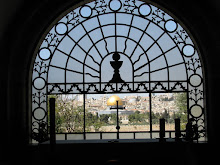Ever since my arrival in Israel, I was trying to visit the ancient city of Shivta near our campus. However, the major hindrance, was to reach Shivta via public transport. The infrequent Metropolin 44 drops at Shivta junction, from where you need to walk 10 km. To hitchike this extremely remote section was really a bad option. Obviously to walk to and fro 20 km was also not advisable. So this trip made an ideal opportunity for me. If you remember my earlier posts, I had been to a city called Avdat. Shivta is also built by the same community who built Avdat, namely the Nabateans (2nd cent BC to 1st cent AD). Not much is known about this ancient community, but the cities they have constructed deep inside the deserts are amazing. In Israel there are almost 6 Nabatean cities, of which Avdat is the biggest. However, the best known Nabatean city is Petra in Jordan (not very far from Israel). Importantly, Petra is one of the new seven modern wonders declared in 2007. Movie freaks who have seen 'Indiana Jone's the Last Crusade' should know that the last scenes of the movie where the Holy Grail was located were shot in Petra.
Ok back to Shivta…. A city located on no major roads with no spring, not even a single well and surrounded by desert of rock and sand. The only source of water was the rain water collected in a pond. Yet 1500 years ago the 2000 inhabitants raised grapes, fruit trees, wheat, barley and herds of sheeps and goats. They built a beautiful community of wide streets, churches and spacious dwellings. That is the unique nature Shivta! It was also known as Sobota, Subeita and Isbeita in ancient world. It is located around 40 km from Beer Sheva and almost same distance from our campus. Most of the structures you see here are built in Byzantine times (3rd-6th cent AD) and the city was abandoned during the 9th or 10th century. Shivta was indeed a Christian city. Today, there are remains of three ancient churches in Shivta. Excavations also indicate the existence of a monastery dedicated to St. Sergius. The northern and the southern churches were built in the 4th century AD and the central church was added later. Shivta spreads in an area of 81,000 square meters and believed to have accommodated 2000 people. Strangely, unlike other Nabatean cities it did not have a city wall. The outer ring of houses formed a protective wall around the city. T. E. Lawrence (Lawrence of Arabia) and C. L. Woolley were some of the archaeologists who worked here. However, the first to dig Shivta extensively was the British archaeologist Dunscomb Colt (1933-1936). Today, his head quarter (Colt Building) serves as an inn and provides desert hospitality. The Greek inscription over the road reads “Good fortune.From his own funds Colt built (this house).
Ok back to Shivta…. A city located on no major roads with no spring, not even a single well and surrounded by desert of rock and sand. The only source of water was the rain water collected in a pond. Yet 1500 years ago the 2000 inhabitants raised grapes, fruit trees, wheat, barley and herds of sheeps and goats. They built a beautiful community of wide streets, churches and spacious dwellings. That is the unique nature Shivta! It was also known as Sobota, Subeita and Isbeita in ancient world. It is located around 40 km from Beer Sheva and almost same distance from our campus. Most of the structures you see here are built in Byzantine times (3rd-6th cent AD) and the city was abandoned during the 9th or 10th century. Shivta was indeed a Christian city. Today, there are remains of three ancient churches in Shivta. Excavations also indicate the existence of a monastery dedicated to St. Sergius. The northern and the southern churches were built in the 4th century AD and the central church was added later. Shivta spreads in an area of 81,000 square meters and believed to have accommodated 2000 people. Strangely, unlike other Nabatean cities it did not have a city wall. The outer ring of houses formed a protective wall around the city. T. E. Lawrence (Lawrence of Arabia) and C. L. Woolley were some of the archaeologists who worked here. However, the first to dig Shivta extensively was the British archaeologist Dunscomb Colt (1933-1936). Today, his head quarter (Colt Building) serves as an inn and provides desert hospitality. The Greek inscription over the road reads “Good fortune.From his own funds Colt built (this house).

No comments:
Post a Comment